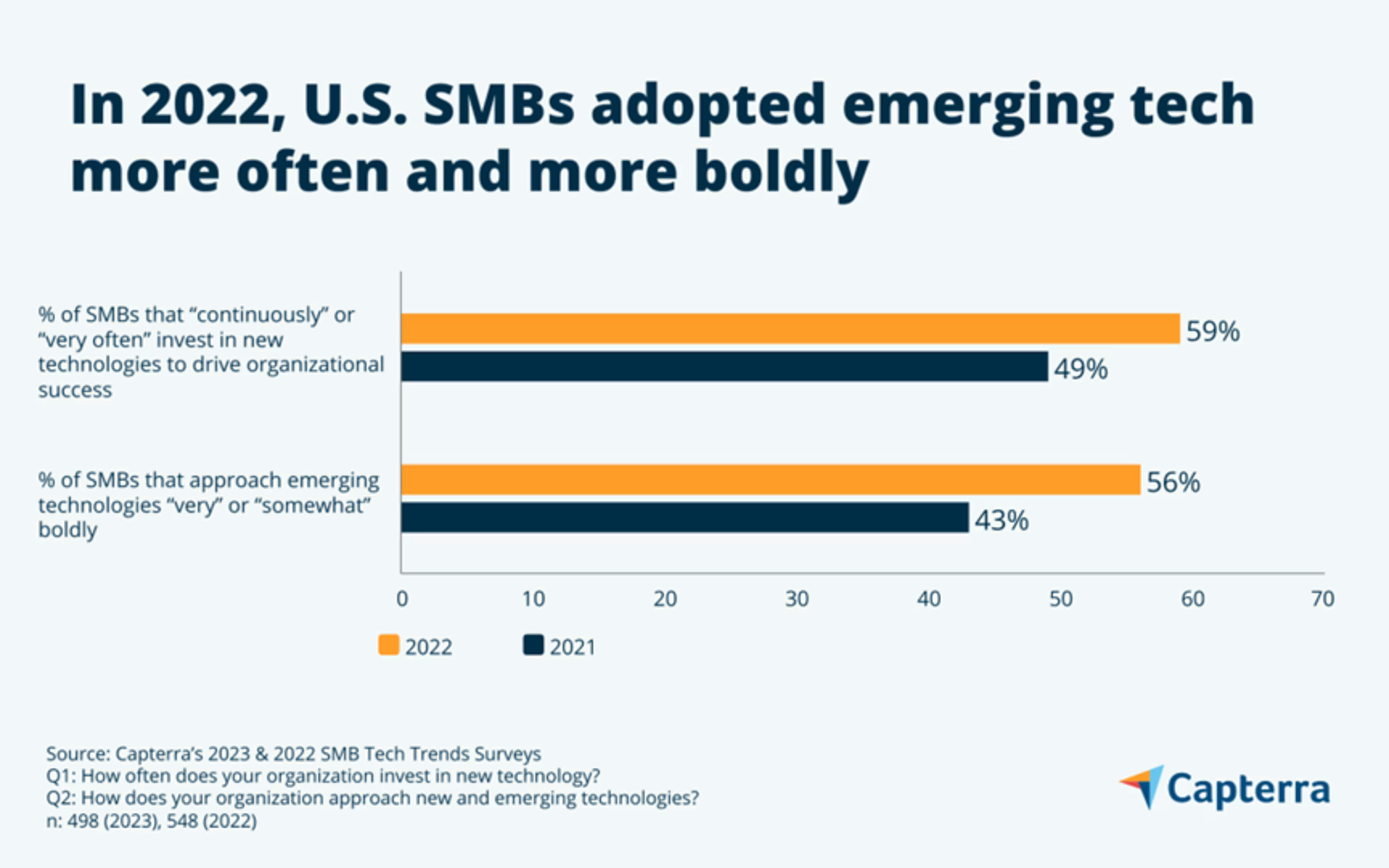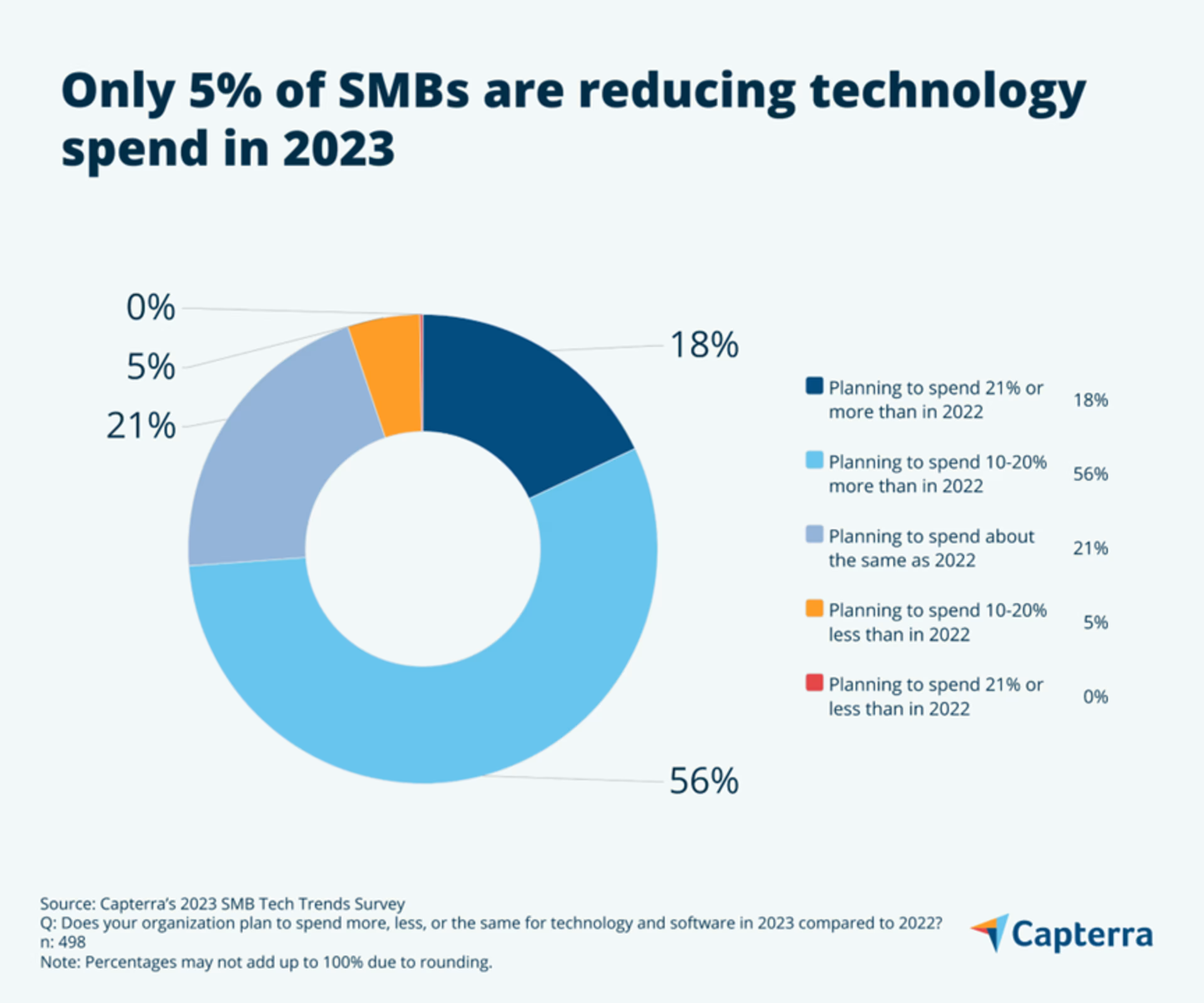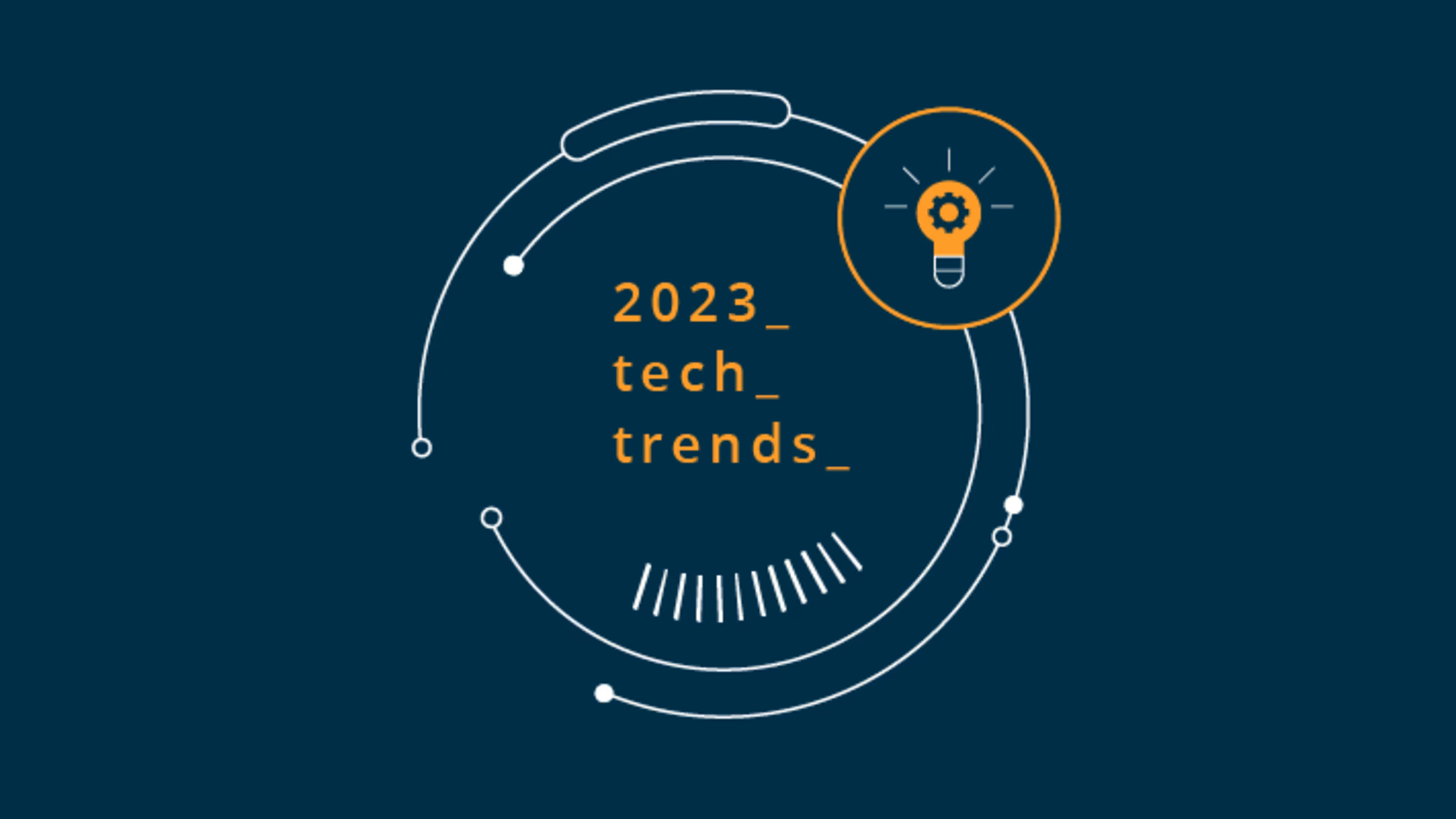61% of U.S. SMBs say they have buyer’s remorse over a technology purchase in the past 12-18 months. We’ll help you avoid a similar fate.
Every year, Capterra surveys hundreds of small and midsize businesses (SMBs) in the U.S.* to understand how they’re approaching and incorporating the latest technology into their operations. 2022 was no different, and our data this year shows some encouraging news: Despite dealing with high inflation and supply chain challenges, small businesses continue to be aggressive in evolving their tech stack with things like advanced cybersecurity and artificial intelligence (AI) to achieve long-term organizational goals.
We also find some not-so-good news. At the same time that SMBs are accelerating their digital transformation, a majority of U.S. SMBs (61%) in our survey say they have buyer’s remorse over a technology purchase in the past 12-18 months. More than one in four (27%) have remorse over multiple tech investments during this time period.
What’s causing a majority of small businesses to make regrettable technology purchases? And what can you do to avoid a similar fate for your business? In this report, we’ll dive deeper into these trends to advise SMBs on how to ensure successful adoption of emerging tech in 2023.
SMBs are adopting emerging tech faster with long-term goals in mind
If SMBs learned anything from the COVID-19 pandemic, it’s that those who move slowly fall behind quickly. Small businesses had to rapidly adopt technology to maintain employee productivity and ensure business continuity just to survive in 2020, and we continue to see ripple effects of this sudden pivot going into 2023.
One such effect is that SMBs don’t want to wait to react when another major external event—such as a new competitor or economic downturn—arises in the future. The number of SMBs that want to respond quickly to these events to avoid falling behind increased from 52% last year** to 63% this year.
As part of their drive to move faster, small businesses in 2022 adopted new technology more frequently, and with more boldness.

Taking this bolder approach, SMBs this year considered valuable emerging tech ranging from advanced cybersecurity software (53%) and AI/ML (machine learning) functionality (42%), to augmented and virtual reality applications (39%).
Where things differ significantly from years past, however, is the end goal for this new, shiny technology. With more businesses settling into a post-COVID groove, the number of SMBs prioritizing long-term goals over short-term opportunities nearly doubled year-over-year from 29% to 51%—with top goals being to grow revenue (44%), grow market share (38%), or increase employee productivity (37%).
All in all, SMBs have overcome significant challenges in recent years, and are using their growing fondness for emerging tech to help them achieve long-term success. But as we’ll explain below, this quicker, bolder approach may be backfiring for many.
Capterra’s 2023 SMB Tech Trends Annual State of Software Adoption Reports capture global trends across industries and reveal how small- and midsize-business leaders are adopting technologies to embrace change, optimize efficiency, and accelerate growth. Our reports are designed to support decision-makers with the insights they need to embrace the right technology and services.
View our 2023 U.S. SMB Software Buying Trends Report to understand why security and implementation should be top-of-mind as you evaluate new technology
View our 2023 State of Marketing Software Adoption Report to discover how marketers are leveraging emerging technology
View our 2023 State of Accounting & Finance Software Adoption Report to see why financial firms are spending more on software
View our 2023 State of IT Software Adoption Report to understand how security concerns are shaping IT technology strategies
View our 2023 State of Manufacturing Software Adoption Report to discover how companies are finding technology without regret
Poor support and higher-than-expected costs are causing rampant purchase regret
As we mentioned at the beginning, 61% of U.S. SMBs in our survey say they have buyer’s remorse over technology purchased in the past 12-18 months. For certain buyers, that number is even higher:
Retailers (74%)have the most buyer’s remorse among industries that report substantial regret.
Larger SMBs with 250-999 employees (66%) have buyer’s remorse more often than smaller SMBs with 49 or fewer employees (53%).
Those who have adopted CRM software for permanent usage (72%) or accounting and finance software for temporary usage (87%) since the start of the COVID-19 pandemic have the highest prevalence of buyer’s remorse.
When asked why they have buyer’s remorse, the top reasons given by SMBs are lackluster support services (39%), the total investment being more expensive than anticipated (34%), or struggling to prove a positive return-on-investment (ROI; 33%).

Vendor support is a critical factor in technology purchase success, and it’s where SMBs are doing themselves no favor by moving fast. Case in point, the top-cited challenge when investing in new technology is compatibility with existing systems. Without taking the time to ensure a new purchase can seamlessly integrate with their existing technology stack, vendor support services can only do so much to piece together a workable solution—especially if a small business lacks a robust IT department to customize their own fixes.
Meanwhile, concerns about cost and ROI go hand-in-hand. And with high inflation making SMBs extremely budget-conscious, those that move too quickly without understanding the total cost of adopting emerging tech or having a solid use case with their purchase in mind risk running into trouble.
Our 5 tips for avoiding software buyer’s remorse
Given all of this, should SMBs go back to being slower or more risk-averse? Not necessarily.
Competition with big businesses that can afford to go slower is fierce, and SMBs should be empowered to adopt anything that will give them an upper hand or prevent catastrophe in another challenging year ahead. Still, given what we now know from our survey data, here are our five tips to reduce your risk of buyer’s remorse with your next emerging tech purchase:
Apply a total cost of ownership mindset: First-time software buyers will often look at the subscription cost of software and determine that must be the price of ownership. It’s not. Add in costs for things like implementation, training, support, and maintenance, and the final price tag can quickly escalate out of budget range. Take some time to understand the true cost of your purchase before determining a suitable budget, and negotiate your service-level agreement (SLA) with any potential vendors early on so you aren’t surprised by hidden costs down the road.
Don’t rely solely on your IT department: In our 2023 U.S. SMB Software Buying Trends Report, we discovered that a majority (52%) of U.S. SMBs solely rely on internal IT professionals to handle the evaluation, selection, and purchase of new software. IT is valuable to figure out the nuts and bolts of implementation, but may overlook important factors such as budget or ease of use. Ensure you include a mix of IT and non-IT workers (preferably end users or department heads) in your purchase group, and that everyone is a full participant in the process.
Take full advantage of free trials and demos: The free trial period is your one chance to get your hands on new tech before you make a purchase decision. Use dummy data, get a number of users involved, and take as much advantage of it as you can to ensure a product fits your organization’s needs. Similarly, demos are the best chance to get one-on-one time with a vendor to ask detailed questions about functionality and capabilities. (You can learn more about how to prepare for a software demo here).
Have a clear internal use case in mind: There’s a tendency, especially with new technology, to adopt now and figure out the best use for it later. AI is a great example. At this point, SMBs are well aware that AI can be beneficial for their organization, but without nailing down a specific process or KPI to apply it to (e.g., reducing duplicate tasks for a department, identifying new cybersecurity threats), these businesses will flounder trying to prove they achieved a positive ROI on their purchase. Our research makes it clear: don’t adopt new technology just because your competitors do.
Keep your options open: While SMBs that preferred off-the-shelf solutions and those that preferred customized solutions reported similar levels of purchase regret (62% and 68%, respectively), those that had no preference at all saw their regret level drop to 32%. Each type of solution has its pros and cons, but keep an open mind on what the best solution for your needs might be. It could even be a free or open source platform.
More challenges await in 2023, but SMBs are increasing their tech spend to meet them
Looking ahead to 2023, SMBs anticipate a mix of challenges new and old. The three biggest challenges in the year ahead, decision-makers say, are economic uncertainties or geopolitical situations (35%), managing and preventing cybersecurity threats (31%), and managing projects efficiently and effectively (31%).
A looming recession, increased borrowing costs, widespread purchase regret—these are all viable reasons for SMBs to decide to reduce their tech spend in the year ahead. Instead, we find the opposite. A majority (56%) of surveyed SMBs anticipate they’ll spend anywhere from 10 to 20% more on technology in 2023, and 18% say they’ll spend even more than that. Only five percent plan to spend less than they did in 2022.

While 2023 looks likely to be another challenging year for SMBs, more and more organizations are realizing that new technology is not a sunk cost to be avoided in hard times. Instead, these businesses are looking to a variety of platforms—from a simple project management system to advanced business intelligence software—to overcome short-term obstacles in the pursuit of long-term prosperity.
If you’re looking to add on to your tech stack in 2023, these resources will help you make the best purchase for your business:
